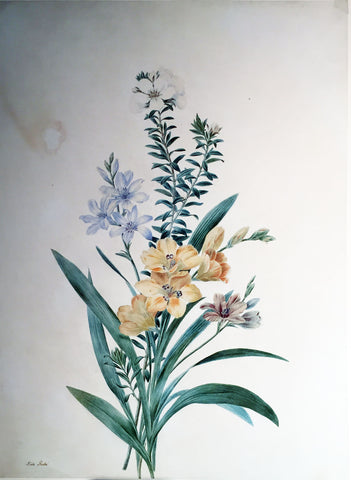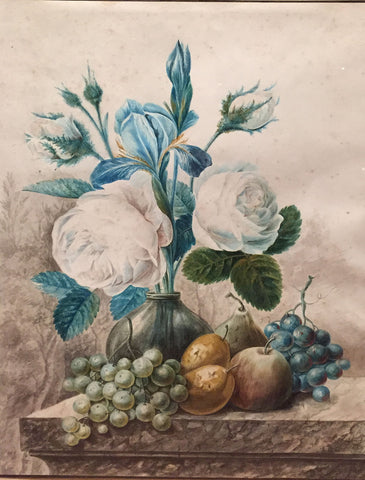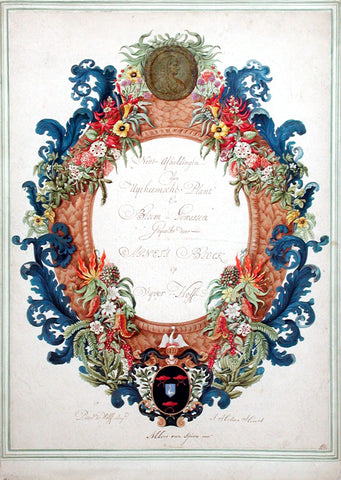Priscilla Susan Falkner Bury (British, 1799–1872), Fine Original Album of Botanical Watercolors [1836-1840]
Priscilla Susan Falkner Bury (British, 1799–1872)
Fine Original Album of Botanical Watercolors
[1836-1840]
4to., (10 4/8 x 8 4/8 in). 26 FINE original botanical watercolors, each signed and dated by the artist, or otherwise inscribed by her, and 9 engraved proof plates with original hand-color from the “Botanist”. Original half maroon cloth, marbled boards, gilt, all edges gilt (extremities worn, binding detached).
Priscilla Susan Falkner “drew plants raised in the greenhouses of her family home, Fairfield (demolished 1913), 2 miles east of Liverpool and, by 1829, had enough studies of lilies and allied plants for publication, a venture promoted by her friend, William Swainson. She modeled her proposed book, then tentatively named ‘Drawings of lilies’, on William Roscoe’s Monandrian Plants (1824–8), with the plates to be accompanied by brief letterpresses based on her notes. Indeed, she even used Roscoe’s book prospectus as a model for her own. In it, she advertised her ‘Drawings of Liliaceous Plants arranged by Botanists in the genera Crinum, Amaryllis, Pancratium ’, to appear in ten numbers, each of five plates to be lithographed by Hullmandel, subscribers paying a guinea a number, others 27s. On 4 March 1830, at Walton on the Hill, Priscilla Falkner married Edward Bury (1794–1858), a railway engineer; the couple had at least three sons, born between 1831 and 1835. In 1831 Priscilla Bury’s drawings began to be published as A Selection of Hexandrian Plants, the large (64 cm × 48 cm) plates being engraved by Robert Havell; the work had only seventy-nine subscribers. Fifty-one plates appeared in ten fascicles, the last in 1834, but whether or not the text is Bury’s is unclear. The plates are fine-grained aquatints, partly printed in colour and retouched by hand: the original drawings later went to Dumbarton Oaks, Washington. The published work has been praised as ‘certainly one of the most effective colour-plate folios of its period’ (Blunt and Stearn, 248). After 1836 Priscilla Bury contributed eight plates to (originals now in NHM) Maund and Henslow’s The Botanist and, in 1860–1, brought out Figures of Remarkable Forms of polycystins, or Allied Organisms, in the Barbados Chalk deposit, with twelve plates of photographic prints of drawings made from microscopic preparations mounted by Christopher Johnson (1782–1866) of Lancaster, from specimens collected by John Davy (1790–1868). About 1865 there was a second edition with twenty-four plates with a photograph of diatoms by Bury and she seems to have issued further separate plates. M. C. Cooke (1825–1914) brought out another edition in 1869 and that included another plate of diatoms, signed P. S. Bury 1869” (D.J. Mabberley for DNB).
Please feel free to contact us with questions by phone at 215.735.8811,
or by email at loricohen@aradergalleries.
We Also Recommend

![Priscilla Susan Falkner Bury (British, 1799–1872), Fine Original Album of Botanical Watercolors [1836-1840]](http://aradergalleries.com/cdn/shop/products/burybook2_1_large.jpg?v=1592488042)
![Priscilla Susan Falkner Bury (British, 1799–1872), Fine Original Album of Botanical Watercolors [1836-1840]](http://aradergalleries.com/cdn/shop/products/burybook2_1_compact.jpg?v=1592488042)
![Priscilla Susan Falkner Bury (British, 1799–1872), Fine Original Album of Botanical Watercolors [1836-1840]](http://aradergalleries.com/cdn/shop/products/burybook2_2_compact.jpg?v=1592488042)
![Priscilla Susan Falkner Bury (British, 1799–1872), Fine Original Album of Botanical Watercolors [1836-1840]](http://aradergalleries.com/cdn/shop/products/burybook2_3_compact.jpg?v=1592488043)
![Priscilla Susan Falkner Bury (British, 1799–1872), Fine Original Album of Botanical Watercolors [1836-1840]](http://aradergalleries.com/cdn/shop/products/burybook2_4_compact.jpg?v=1592488043)
![Priscilla Susan Falkner Bury (British, 1799–1872), Fine Original Album of Botanical Watercolors [1836-1840]](http://aradergalleries.com/cdn/shop/products/burybook2_5_compact.jpg?v=1592488043)
![Priscilla Susan Falkner Bury (British, 1799–1872), Fine Original Album of Botanical Watercolors [1836-1840]](http://aradergalleries.com/cdn/shop/products/burybook2_6_compact.jpg?v=1592488043)




